|
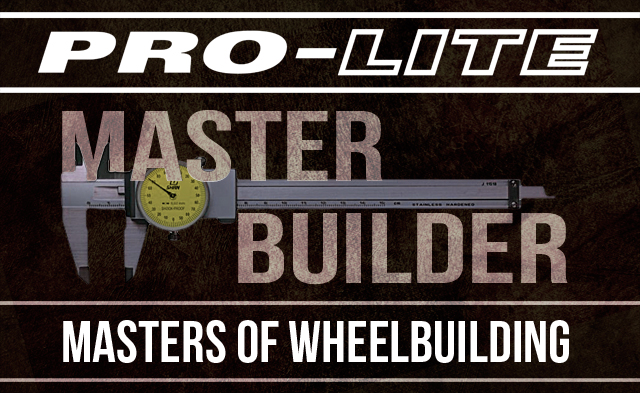 Building thousands of wheels every year, our factory staff can certainly be said to be among the most experienced in the business. Every stage of wheel building is carried out completely by hand, using the best quality tools customized to be the best for every job. Building thousands of wheels every year, our factory staff can certainly be said to be among the most experienced in the business. Every stage of wheel building is carried out completely by hand, using the best quality tools customized to be the best for every job.
If you watch a wheel being built at your local bike shop, you will probably see some of the basic steps:
lace up, quick tighten, first tension, check dish, tweak the tension, then put the wheel on a stand to even up the tension and fine tune the trueness and roundness. Some of the better shops will even use a tensiometer and might even do a bit of bedding in by pushing the hub against the ground...
Compare that to the stringent standards used by Pro-Lite. The initial stages are fairly similar, but the difference is found in taking the time to prepare the wheel as much as possible, checking and re-checking and checking again. We even check and re-check the tools, carefully monitoring the longevity of the springs and keeping calibrated, never being more than a few hours away from calibration.
We took a camera in and watched a wheel as it went through the process here at the biggest exclusively hand-built wheel factory in the world. |
 |
From the very first stages, the wheel is built by experienced hands. The builder here is Mrs. Cai, who has been building wheels for well over 20 years. Her watchful eye and skillful fingers look for defects in spokes, nipples, threads, hub and rim before the wheel moves to the next station.
|
The next step sees the wheels go through the quick-tighten, with an air drill set to a low speed and clutched to very low resistance, well below tension thresholds. The builder is able to hold the spoke loosely without danger of overtightening. |
|
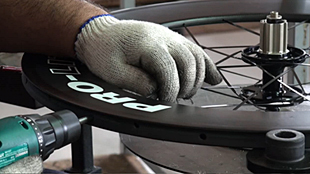 |
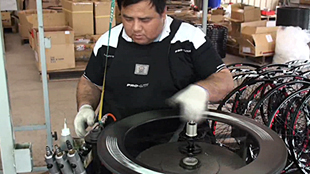 |
With the wheel loosely tightened, it is now ready to go for tensioning. Working this station today is Mr. Zhen, who is one of the newer employees, with only 8 years of wheel building experience, but still with the experience of thousands of wheels built.
|
The wheel then moves to the first tensioning stage. Every aspect of the wheel is examined as it is worked up to a near-usable tension level. Dish, roundness and trueness are all brought to a basic platform that for some factories would be good enough to package and send out the door. |
|
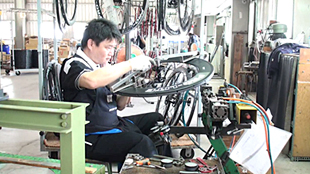 |
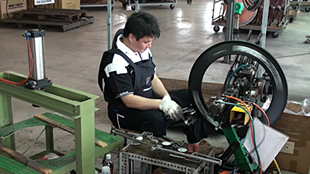 |
| The wheel building stand we use is fitted with all sorts of testing equipment that allows the builder to watch every dimension of the wheel. |
Extreme precision is a priority at our factory. As the largest customer of DT Swiss tensiometers, we make sure that all of our builders are skilled at maintaining, using and rebuilding the tools of their trade. These gauges are each numbered and the amount of correction needed at each recalibration is monitored. When the tool is tired, it is rebuilt or tossed. |
|
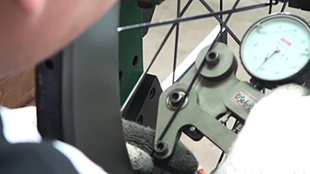 |
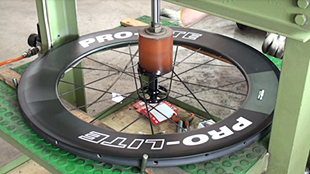 |
This machine sits conveniently next to the wheel building machine so the wheel can be bedded in with strong, consistent lateral forces appropriate for the type and number of spokes.
|
Then, it's back on the stand for another check.
This process is repeated several times and is responsible for the wheels being able to stay as true as they were when they came out of the box. |
|
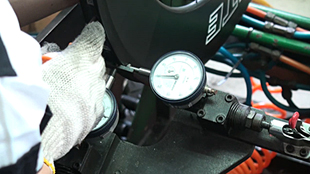 |
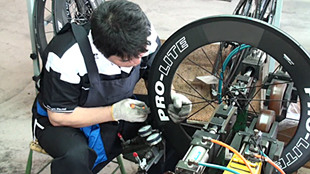 |
Once the wheel is tweaked to perfection, it's not finished yet! The wheel will move onto a rack to relax and move on to the QC department, headed up by a graduate of an engineering technical institute who has been working in the bicycle industry for 20 years since he cut his teeth as a mechanic working on F-16 fighter jets.
|
In this final stage, the wheels are put through their paces in a variety of tests designed to reflect real world usage by real riders. |
|
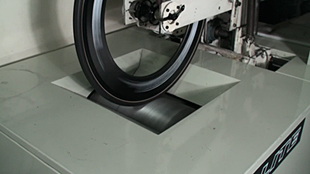 |
|